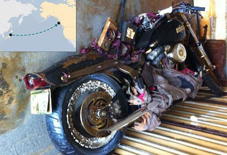 Cleanzine: your weekly cleaning and hygiene industry newsletter 18th April 2024 Issue no. 1110
Cleanzine: your weekly cleaning and hygiene industry newsletter 18th April 2024 Issue no. 1110
Your industry news - first
The original and best - for over 20 years!
We strongly recommend viewing Cleanzine full size in your web browser. Click our masthead above to visit our website version.
Welcome to the
![]()
Cleanzine - the original Cleaning & Hygiene industry e-news
Read by industry professionals in 163 countries worldwide!
There’s an interesting article on the BBC’s website about debris washed into the ocean by the earthquake-triggered tsunami which hit Japan’s north-eastern coast five years ago tomorrow, on 11th March 2011. Whole towns were washed away and as well as the enormous loss of life; it is estimated that about 20 million tonnes of material ended up in the sea as a result of the disaster.
 While much of this material sank, some is still washing up along the North American coast and it’s being tracked by the National Oceanic & Atmospheric Administration’s Marine Debris Programme, which is attempting to identify the items and reconcile them with their owners. Since September 2015, 64 items officially identified as tsunami debris have been washed ashore, from Alaska to Hawaii, including this Harley-Davidson motorcycle (image courtesy of the NOAA), which was found on Graham Island in British Columbia, Canada, in the container its Japanese owner, Ikio Yokohama, had used to store it, back in Japan.
While much of this material sank, some is still washing up along the North American coast and it’s being tracked by the National Oceanic & Atmospheric Administration’s Marine Debris Programme, which is attempting to identify the items and reconcile them with their owners. Since September 2015, 64 items officially identified as tsunami debris have been washed ashore, from Alaska to Hawaii, including this Harley-Davidson motorcycle (image courtesy of the NOAA), which was found on Graham Island in British Columbia, Canada, in the container its Japanese owner, Ikio Yokohama, had used to store it, back in Japan.
Ikio – who lost several family members in the tsunami, decided that rather than accept offers to have it shipped back to him, it should be exhibited at the Harley-Davidson Museum in Milwaukee, US, as a memorial to others whose lives were touched by the disaster.
The report notes that while the biggest items have received the most attention, the vast majority of the debris was smaller. Much of it is entirely or mostly sub-surface and can only be moved by currents, which means that a great deal of it has accumulated in an area known as the Great Pacific Garbage Patch – a long-standing collection of marine debris.
The article paints a very graphic picture of not only how long our rubbish will contaminate our oceans, but just how far it can travel whilst doing so. I wonder whether it will make enough of us who see it, think twice though – before carelessly discarding unwanted items and rubbish – and make a difference to the amount left bobbing around in the sea? For while catastrophic events such as the tsunami will do their damage without mankind’s help, smaller events such as a carelessly discarded plastic bottle, or plastic bag, or nappy – when added up globally – can do quite a damage too, can’t they?
Please get in touch either by emailing me or posting a comment on our Facebook page. www.facebook.com/Cleanzine
![]() You can also follow us on Twitter @cleanzine
You can also follow us on Twitter @cleanzine
Yours,

10th March 2016








